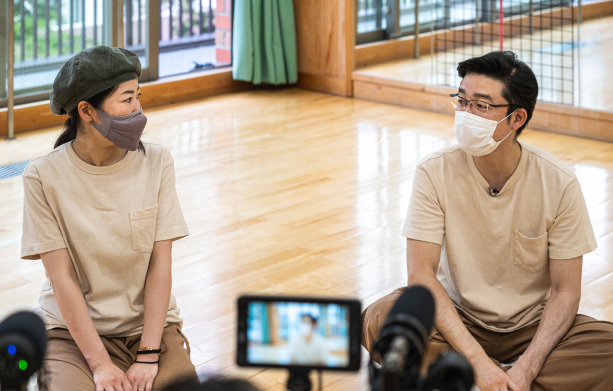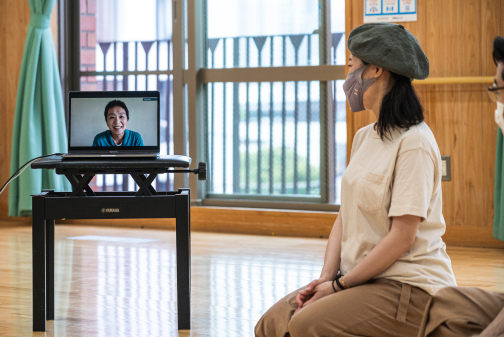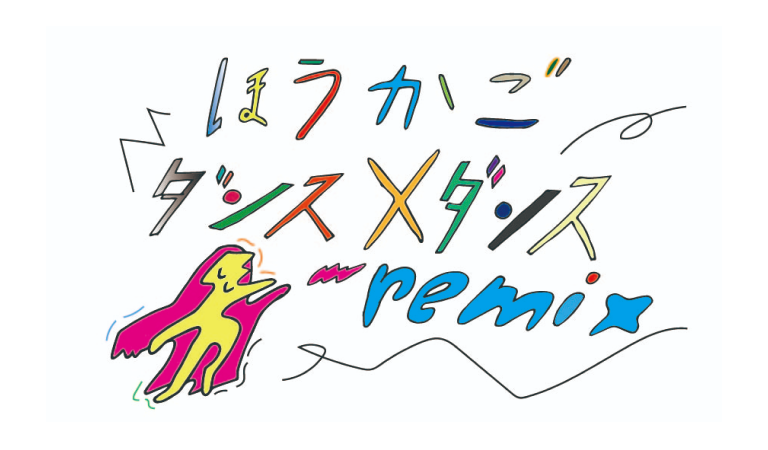Reflecting on the ADD Minato City Project
"Experience is Definitely Accumulated"
Kikunojo Onoe
Dispatched Dance Expert
Mari Fukutome
Researcher
Mikico Suto
Choreography Assistant

――We had a wide range of dances lined up for Minato City. How do you feel looking back?
Kikunojo Onoe (KO): First of all, we were able to encounter a lot of different dances that were new to us. My first interest was the dance from Afghanistan. I was so curious about what it was like. And I liked how capoeira was somewhere between dance and play. Even as adults, it was very interesting to experience unfamiliar dances.
Mari Fukutome (MF): Indeed. Children were also able to learn about the dances that are different from hip hop or ballet, and I hope they recognize that there are people in their local neighborhood who enjoy them as well.
KO: Rather, the children don't have the sense of that kind of boundary. Adults have some sort of standards within them when encountering something new, but since children don't have that, they could absorb any dance from any country in the same way.
MF: It seemed definitely convincing for children to see an "experienced local" demonstrate a dance in front of them. I felt that they were able to understand it instantly, and that transmission from body to body helped their interest grow.
KO: I think that any dance has its own logic. For instance, when you do capoeira, you avoid what comes toward you, and move around in the most economical way, according to the style's internal logic of body control. On the other hand, Chinese dance uses one's energy stored within. Though it's boring to the children when we explain this with words (Iol), the children are able to build experience when actually trying them out. They may not fully realize what they're doing at the moment, but when they encounter something new again after some time, these experiences they've gained here may potentially help them understand it. I think it's extravagant to gain multiple references of this kind. And even when you may not have any occasion to utilize them at all, that doesn't mean they are meaningless. Because these experiences are definitely accumulated within you.
Mikico Suto (MS): I'd be happy if these ADD experiences become an opportunity for these children to develop their sense of body and way of thinking. I, in fact, hated answering the question, "What do you want to be when you grow up?" It was as if I knew what was out there in the world for me to be asked like that as a young child... (Iol). But now I know that having an understanding can sometimes follow your experience. There are people who chose a certain dance by their own will, and there are people like Kikunojo Onoe and Lei Huang, who started the training not with their own will but someone else's during their childhood, and then gradually found many fun moments within the discipline. It's great to hear from those who had that kind of experience, which is why I liked to start our sessions every time by asking the instructor, "Why and how did you start dancing in this style?"

――Mikico's facilitation was very effective as a bridge between various dances and children.
MF: I think it was awesome to see different dances sharing the same moment in such a natural manner. For instance, when the participants were moving around, making a bull's horn with their hands in the flamenco part, Kikunojo and other adults were joining them. That site convinced me that the mixture of various dances has a great significance.
MS: Also in other classes, it was interesting to see the adults, all with different dance techniques, dancing behind the children in their own interpretation. The "remix" of dances were happening there as well (lol).
KO: When you think about it, even Japanese classical dance has been accepting influences of other dance styles like ballet, especially after the Meiji era. For instance, when we stretch a part of the body, it contains a sense of rotundity just like in Chinese dance, but it can also mean to stretch straight ahead, depending on the performed piece. These influences were made through Russian ballet's visits to Japan. There's no right or wrong in dance, Rather they all share the same roots and are fundamentally connected with one another. The act of prayers to obtain food to live, or the gestures in rituals wanting to communicate with gods, has all been linked to today's dances of ours and evolved through the history we live in.
――The idea of bringing in Choju-Giga (Scrolls of Frolicking Animals) in the final showing was highly Inspiring.
MF: It was easy for the children to understand, and the instructors were able to pick up animal-like motions or characters from their respective dance styles to bring into the piece. A really great idea.
KO: If time allowed, we wanted to get more into detail of the animal images, like, imagining what kind of bull was the one represented in flamenco, as Sayaka Masaki showed us. The frog's back kick or jump in capoeira could also be developed further in some way.
MF: I remember being fascinated by Lei's expression of "walking on clouds", when explaining a bird's walk. When you picture that image, the children would better under-stand the idea of "fluff", rather than being told to plant your feet from heel to toe.
KO: Indeed. Imagery is important in learning dance. On top of that, animal gestures are easy for children to imagine concretely. In Kachi-kachi Yama (Fire-Crackle Mountain) for example, we would use "hot!" as a gesture of sensing the fire on your back. And moving around to shake the fire off in your own manner, that becomes a dance. Here lies the freedom of dancing.


